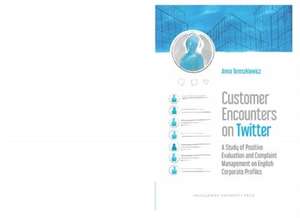Customer Encounters on Twitter – A Study of Positive Evaluation and Complaint Management on English Corporate Profiles
Autor Anna Tereszkiewiczen Limba Engleză Paperback – 28 feb 2022
Preț: 315.46 lei
Nou
Puncte Express: 473
Preț estimativ în valută:
60.36€ • 63.02$ • 49.96£
60.36€ • 63.02$ • 49.96£
Carte disponibilă
Livrare economică 14-28 martie
Livrare express 27 februarie-05 martie pentru 25.21 lei
Preluare comenzi: 021 569.72.76
Specificații
ISBN-13: 9788323346579
ISBN-10: 8323346577
Pagini: 252
Dimensiuni: 159 x 235 x 14 mm
Greutate: 0.23 kg
Editura: Jagiellonian University Press
ISBN-10: 8323346577
Pagini: 252
Dimensiuni: 159 x 235 x 14 mm
Greutate: 0.23 kg
Editura: Jagiellonian University Press
Notă biografică
Anna Tereszkiewicz
Cuprins
Acknowledgements
Introduction
Chapter 1. Social media and corporate communication
1.1. Social media as a channel of communication
1.2. Social media and marketing communication
1.3. Social media and electronic word-of-mouth communication
1.4. Twitter as a microblogging service
1.5. Twitter in corporate communication
Chapter 2. Customer encounters as a genre of social interaction
2.1. Customer encounters as a genre of social interaction ¿ basic characteristics
2.2. Previous research into customer encounters
2.2.1. Face-to-face customer encounters
2.2.2. Call centre interactions
2.2.3. Online customer encounters
2.3. Crisis communication, complaint and review management
2.3.1. Crisis communication, complaint and review management in traditional channels of interaction
2.3.2. Online crisis communication, complaint and review management
Chapter 3. Corporate profiles on Twitter ¿ general characteristics
3.1. Company profiles ¿ structure and types of posts
3.2. Modes of interaction on the profiles ¿ discursive blending
Chapter 4. Positive evaluation and complaint management on Twitter
4.1. Methods and materials
4.1.1. Methods
4.1.2. Materials
4.1.3. The structure of customer encounters on Twitter
4.2. Consumer positive evaluation on Twitter
4.2.1. Consumer positive evaluation on Twitter
4.2.2. Positive review management
4.3. Consumer complaint and negative evaluation management on Twitter
4.3.1. Consumer complaints on Twitter
4.3.2. Complaint management ¿ responses to complaints and negative evaluations
Chapter 5. Selected politeness and lexicogrammatical properties of the tweets
5.1. Methods
5.2. Conventional politeness acts: openings and closings, forms of address and self-identification in the tweets
5.2.1. Address forms
5.2.2. Self-identification
5.2.3. Opening sequences
5.2.4. Closing units
5.3. Selected lexicogrammatical properties of the tweets
5.3.1. Informal and non-standard language, mistakes
5.3.2. The use of emoticons, hashtags and links
Conclusions
References
Introduction
Chapter 1. Social media and corporate communication
1.1. Social media as a channel of communication
1.2. Social media and marketing communication
1.3. Social media and electronic word-of-mouth communication
1.4. Twitter as a microblogging service
1.5. Twitter in corporate communication
Chapter 2. Customer encounters as a genre of social interaction
2.1. Customer encounters as a genre of social interaction ¿ basic characteristics
2.2. Previous research into customer encounters
2.2.1. Face-to-face customer encounters
2.2.2. Call centre interactions
2.2.3. Online customer encounters
2.3. Crisis communication, complaint and review management
2.3.1. Crisis communication, complaint and review management in traditional channels of interaction
2.3.2. Online crisis communication, complaint and review management
Chapter 3. Corporate profiles on Twitter ¿ general characteristics
3.1. Company profiles ¿ structure and types of posts
3.2. Modes of interaction on the profiles ¿ discursive blending
Chapter 4. Positive evaluation and complaint management on Twitter
4.1. Methods and materials
4.1.1. Methods
4.1.2. Materials
4.1.3. The structure of customer encounters on Twitter
4.2. Consumer positive evaluation on Twitter
4.2.1. Consumer positive evaluation on Twitter
4.2.2. Positive review management
4.3. Consumer complaint and negative evaluation management on Twitter
4.3.1. Consumer complaints on Twitter
4.3.2. Complaint management ¿ responses to complaints and negative evaluations
Chapter 5. Selected politeness and lexicogrammatical properties of the tweets
5.1. Methods
5.2. Conventional politeness acts: openings and closings, forms of address and self-identification in the tweets
5.2.1. Address forms
5.2.2. Self-identification
5.2.3. Opening sequences
5.2.4. Closing units
5.3. Selected lexicogrammatical properties of the tweets
5.3.1. Informal and non-standard language, mistakes
5.3.2. The use of emoticons, hashtags and links
Conclusions
References













